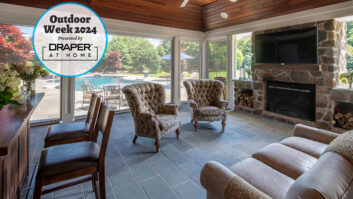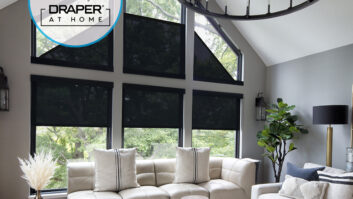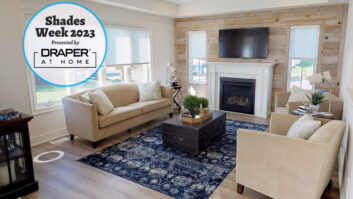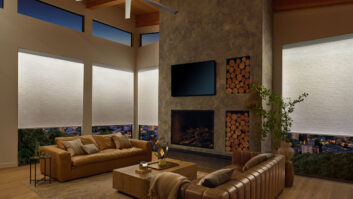As an acoustic design firm, we often face challenges related to heating, ventilating, and air conditioning (HVAC) system designs for screening rooms. Some of you might be in the same boat, so I thought I’d share a few of our insights on the subject.
Making it Comfortable
Acousticians get hot like everyone else. I’ll even concede that comfort, not quiet, is the primary objective for an HVAC system. After all, if the system isn’t comfortable, no one’s going to be around to care if it’s noisy.
Two things affect comfort: air temperature and humidity. Fortunately, modern HVAC systems can control both, and I highly recommend that your client install a system that will humidify and de-humidify the air. This is especially true for projects in very humid (southeastern U.S.) or dry (southwestern U.S.) climates.
The most important thing to remember is that HVAC systems work by raising or lowering the temperature of the entire air mass in the room-not by blowing hot or cold air on people. Someone has to engineer the system to move enough air through the room to evacuate the heat produced by things in the room (people, lights, electronics, video projectors, etc.) You may be tempted to try it yourself; don’t. Hire a qualified HVAC engineer.
Your part is to provide the engineer with heat dissipation data (how much heat is generated in the room). This is typically some number of BTU per hour (BTU/h). The human body produces about 350 BTU/h. Most of the electricity drawn by a light or AV component also turns into heat, so wattage specifications are a pretty accurate measure of heat dissipation. You can convert wattage into BTU/h using 1 W = 3.4 BTU/h, or simply log on to www.onlineconversion.com. From the heat dissipation data, the HVAC engineer can determine how much cooling and heating power is needed.
Don’t forget fresh air! I worked on a theater that, by mistake, used only re-circulated air. It was completely quiet and held temperature perfectly. However, 12 people sitting in there for two hours would have produced enough carbon dioxide to kill a small army. In fact, carbon dioxide detectors aren’t a bad idea.
Making it Quiet
The HVAC system has to be quiet enough to preserve the dynamic range of the sound system. Dynamic range is the difference between the loudest sound the system can produce and the level of background noise in the room. HVAC obviously affects the latter. In worst-case scenarios, HVAC systems can be so loud that they drown out dialog.
Let’s start by looking at compressor noise. Compressors are outdoors, which probably means they’re OK even if they’re right outside a screening room. General media-oriented spaces with windows are different. Windows are notorious sound-sieves, which means that compressor noise will leak in unless you go with sound-rated windows.
Refrigerant lines are going to be heavily padded and insulated already, so you probably don’t have to worry about them. If they run close to the screening room, make sure the installer doesn’t punch any holes in the sound isolation shell.
Furnaces (or air handlers) are the real killers. They produce noise in two ways:
- The fan motor generates mechanical noise and vibrations that transmit to the rest of the house through any rigid physical contact between the furnace chassis and the house. The airborne sound of the motor also leaks through the ducts into the screening room. Direct transmission of sound into the screening room is unlikely to be a problem, because high-end furnaces are fairly quiet.
- The fan blades generate wind noise as they slice through the air. This noise follows the ducts out into the screening room.
To silence a furnace, you first need to mechanically decouple it from the house to eliminate vibration noise. This is best accomplished by placing the chassis on springy pads (rubber, cork, or actual springs) or flying it with spring hangers. If you use springs, be sure to introduce some form of rubber or vinyl between at least one hard contact point (such as the junction of the fly rod and the fly point on the furnace).
This keeps nasty little resonant vibrations from traveling up the flying system, through the metal windings of the spring, and into the superstructure of the house. Metal springs themselves do not eliminate this kind of vibration. For safety reasons, always be sure the springs used to fly a furnace are rated to support its weight. Second, you need to decouple the furnace from anything attached to it that also touches the house. I’m talking about supply and return plenums, exterior exhaust vents, drain pipes, and gas and refrigerant lines.
Third, beware of variable-speed furnaces and zoned ductwork. On the surface, they seem like a great solution for screening rooms. However, the air velocity in the supplies dramatically increases when zones shut down. Ductwork doesn’t generate noise, but ducts, diffusers, and grates can still be problematic. Fortunately, they also provide the means to silence a lot of noise, when you’ve taken the following steps:
- Run acoustic-rated flex duct or some kind of fixed duct with a soft interior lining. Unfortunately, recent studies have found that harmful mold can grow inside it, especially in humid climates. So, be sure to use flex duct that has been properly treated.
- Insert duct silencers on the supplies and returns. Duct silencers can impede air velocity, so be sure to provide insertion loss numbers to the HVAC engineer. He or she will need to figure that into the system’s design to avoid excessive static pressure buildup.
- Employ larger ducts and more diffusers than normal. The same amount of air can be moved with less speed and noise. The velocity at each diffuser should not exceed 350 feet per minute (250 feet per minute for high-end applications), while the main duct velocity should not exceed 600 feet per minute.
- Introduce multiple 90-degree turns in the ductwork. This further reduces fan noise.
- Hang ducts from something flexible. Although ducts that are decoupled from the furnace will likely be vibration-free, the safe approach is to use flexible hangers (straps instead of wire, for example).
- Watch those penetration points. The sound isolation shell of a screening room must be protected. Acoustic or non-hardening caulk is your friend. Seal all duct penetrations carefully, and provide a good length of insulation around the ducts near penetrations.
- Finally, use common sense when selecting diffusers and grates. If a diffuser looks like it significantly redirects airflow, then it’s probably going to be noisy.
Tie in Control
For starters, be sure there is a temperature sensor in the screening room. While a centrally located thermostat may work for the normal heat load in a house, screening rooms are anything but normal. When the screening room heats up, the system needs to come on to cool it down.
It’s also a good idea for the control system to engage cooling or heating automatically. The screening room may require heat to make it warm when people first enter, then cooling to keep it comfortable after people have been in there for several hours.
Finally, please tie it into the control system for the room. One of the first things I do when I pick up the Crestron or AMX panel for a screening room is flip to functions like HVAC and lighting control. Most panels have buttons assigned to those functions, but rarely do these buttons actually work. The client should be able to pick up his panel and check the temperature and humidity in the room. It would also be nice if he or she could check fan status. Seeing high fan speed while hearing silence is very gratifying-not to mention a great way for clients to impress friends.
Chase Walton contributed to this article.







